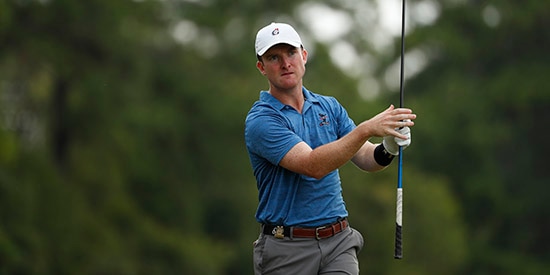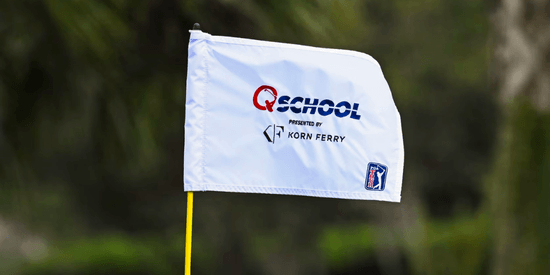Behr reps Class of '11 at U.S. Mid-Am with stroke-play medal
9/23/2018 | by Julie Williams of AmateurGolf.com
see also: View results for U.S. Mid-Amateur, Sand Valley Golf Resort - Sand Valley

Stephen Behr emerged from the talented Class of 2011 to take a job with Ernst and Young and travel the amateur golf circuit
That’s because Behr, 25, was among them. That was back when the future of the PGA Tour was doing the American Junior Golf Association tour.
You don’t have to be good with numbers, as Behr is, to see that a career spent going toe-to-toe with such players would require an absurd amount of talent. Not that Behr isn’t talented (and in the context of most amateurs, absurdly so), but Behr always had other plans for himself. Call this week a different means to qualifying for some of those Tour events – the U.S. Open, the Masters – that Thomas and Spieth frequent.
Behr was a second-team All-American at Clemson and a first-team All-ACC selection. He and Trip Kuehne, who played at Arizona State, are believed to be the only All-Americans to turn down a professional golf career over the past 25 years. Behr’s decorated Clemson career also included the Byron Nelson Award. He was the first player to win it in program history. So understandably, there were questions about his future.
“Even in college, people always said, ‘You don’t plan on going professional?’” Behr remembers. “I was like, ‘No, I’m going to win the Mid-Am and play the Masters.’ So I’ve had this vision for a while.”
Once again, Behr had done the math, and he knew that the first year he was eligible to compete in this tournament (a player must be 25 by the first day of the championship), it would be played in Charlotte, roughly 100 miles northeast of his boyhood home of Florence, S.C. He had played both host courses in junior golf.Stephen Behr posted a pair of sub-70 rounds at Charlotte C.C. and Carolina G.C. to earn medalist honors in the 38th #USMidAm 👏👏https://t.co/Vjp1Ja54vf pic.twitter.com/kpjU8hFuNQ
— USGA (@USGA) September 24, 2018
On Sunday, he had a 3-under 68 at stroke-play companion course Carolina Golf Club. At 5 under for 36 holes, Behr ended up as the stroke-play medalist by two shots. This is just his third USGA championship
As other players withered in the Carolina heat this weekend, Behr soldiered on. He grew up putting on Bentgrass greens and hitting off Bermudagrass fairways. There isn’t a better place for Behr to have made his mid-am debut than right here in the Southeast.
“This is kind of my element, for sure,” he said.
“Besides the start, I didn’t play that badly,” Hagestad said. “It’s tough because the greens are getting really firm. There were a few tricky, tough pins. We were close, we just didn’t do anything spectacular."
Behr’s week continues now that the championship turns over to match play. He’ll miss a few more days of work, but the word is out at Ernst and Young about the caliber of young player the company has brought on board.
At first, Behr’s co-workers at the Atlanta offices were uncertain of the level at which Behr had played this game. Slowly, they began to understand. Behr also joined the Golf Club of Georgia, where he played for the club championship last year. He lost to Erik Martin, a former N.C. State player, in the final.
It was good preparation for this week, but the better prep work came in Scotland over the summer. Behr took a dream buddy trip, teeing it up at the Old Course at St. Andrews, Carnoustie and Turnberry, among other places.
“I think that kind of tuned me up,” Behr said. “Playing eight days in a row really got me to where I wanted to be.”
He’s not all the way there just yet. The final evaluation can only be made on Thursday.
Results: U.S. Mid-Amateur
| Place | Player | Location | Pts | Scores |
|---|---|---|---|---|
| Win | Jacksonville, FL | 1000 | ||
| Runner-up | Charlotte, NC | 700 | ||
| Semifinals | Newport Beach, CA | 500 | ||
| Semifinals | Valencia, CA | 500 | ||
| Quarterfinals | Vidalia, GA | 400 |
About the U.S. Mid-Amateur
The U.S. Mid-Amateur originated in 1981 for the amateur golfer of at least 25 years of age, the purpose of which to provide a formal national championship for the post-college player. 264 players begin the championship with two rounds of sroke play q...
Most Popular Articles

2025 PGA TOUR Q-School Guide: Sites, Scores, and Who Advanced
Dec 5, 2025Second Stage is complete and Final Stage awaits at Sawgrass — follow every Q-School leaderboard and the players still chasing
2025 LPGA TOUR Q-Series: Final Qualifying Stage FINAL SCORING
Dec 8, 2025Helen Briem earns medalist honors, 31 players headed to the LPGA next year
Australian Open at Royal Melbourne: Preview, amateur bios, and how to watch
Nov 30, 2025Rory McIlroy headlines one of the championship's top fields in years - at least four amateurs will have their chance at glory
Luke Ringkamp Cruises to Rolex Tournament of Champions Title at TPC San Antonio
Nov 26, 2025One week after committing to Pepperdine, Luke Ringkamp won the Rolex Tournament of Champions by nine shots.Inside Gil Hanse’s Restoration of Baltusrol’s Upper Course: A Return to Tillinghast’s
Dec 11, 2025Renowned architect Gil Hanse reveals how he brought Baltusrol’s Upper Course back to life by honoring A.W. Tillinghast’s original